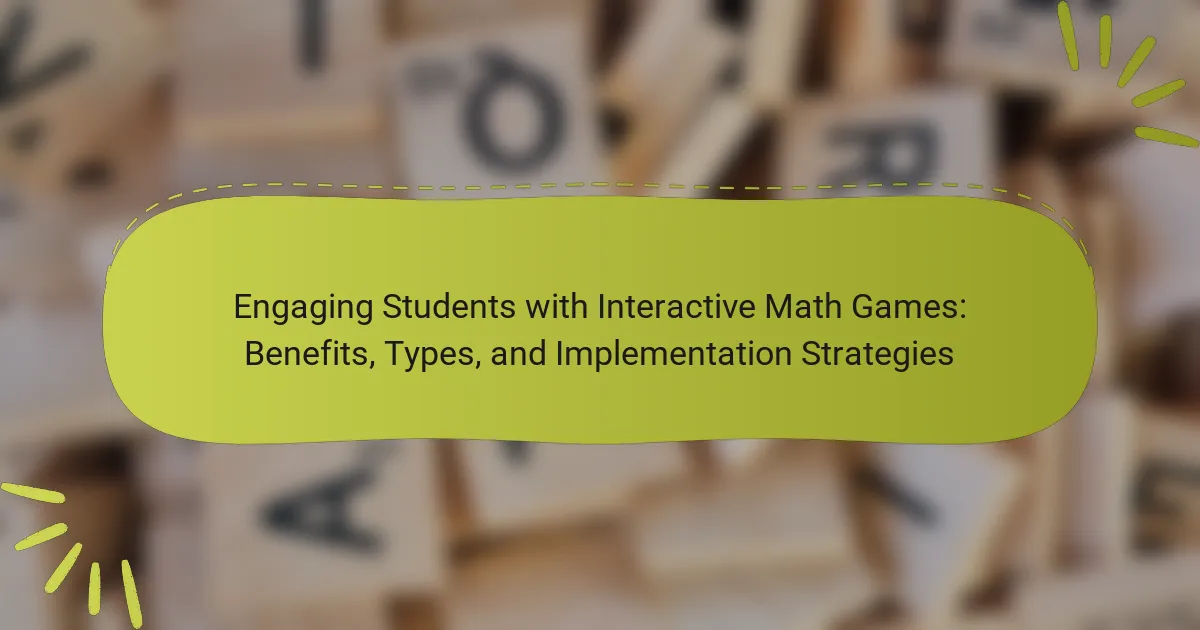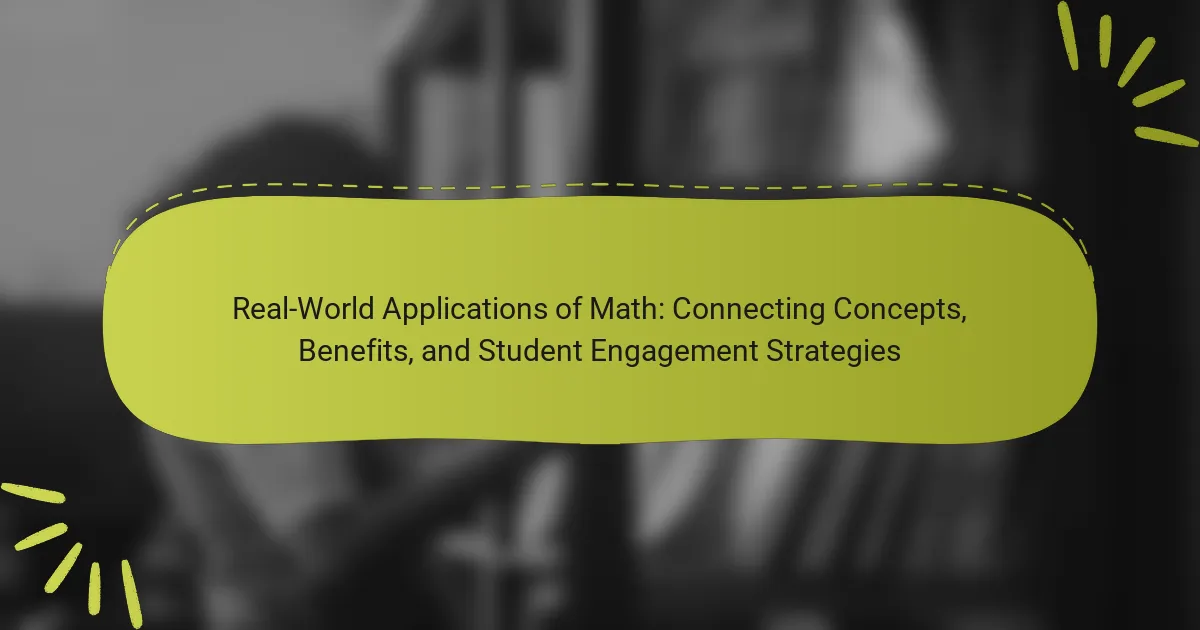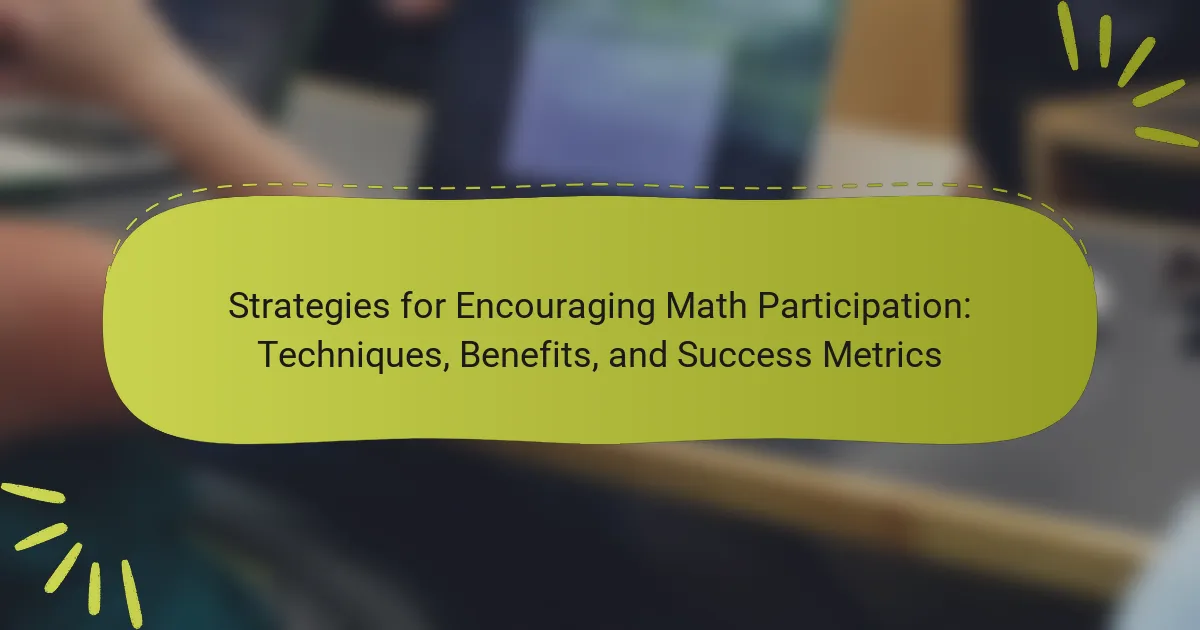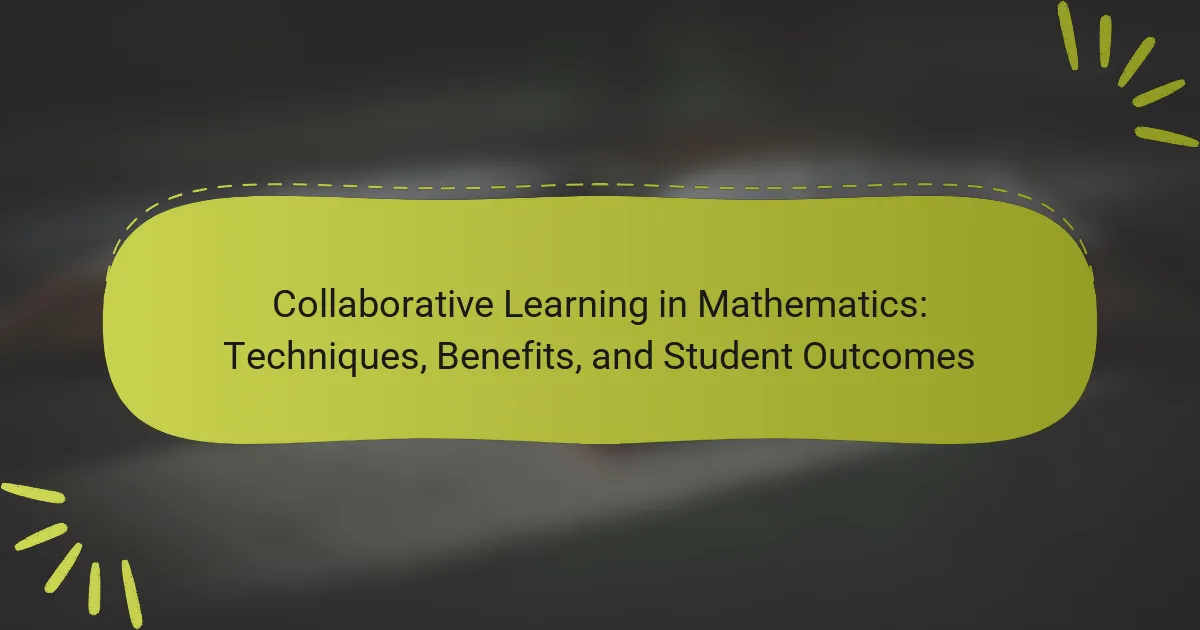Gamification in math learning involves the integration of game-design elements, such as point scoring, leaderboards, and challenges, into educational settings to enhance student engagement and motivation. Research demonstrates that incorporating these elements into math lessons leads to increased participation and improved performance among students. Notable examples of successful gamification in math education include programs like Kahoot!, Prodigy Math, and Mathletics, which have shown significant positive effects on student motivation and learning outcomes. These platforms not only foster a sense of achievement and competition but also promote collaboration and adaptability in learning, making math education more interactive and enjoyable.
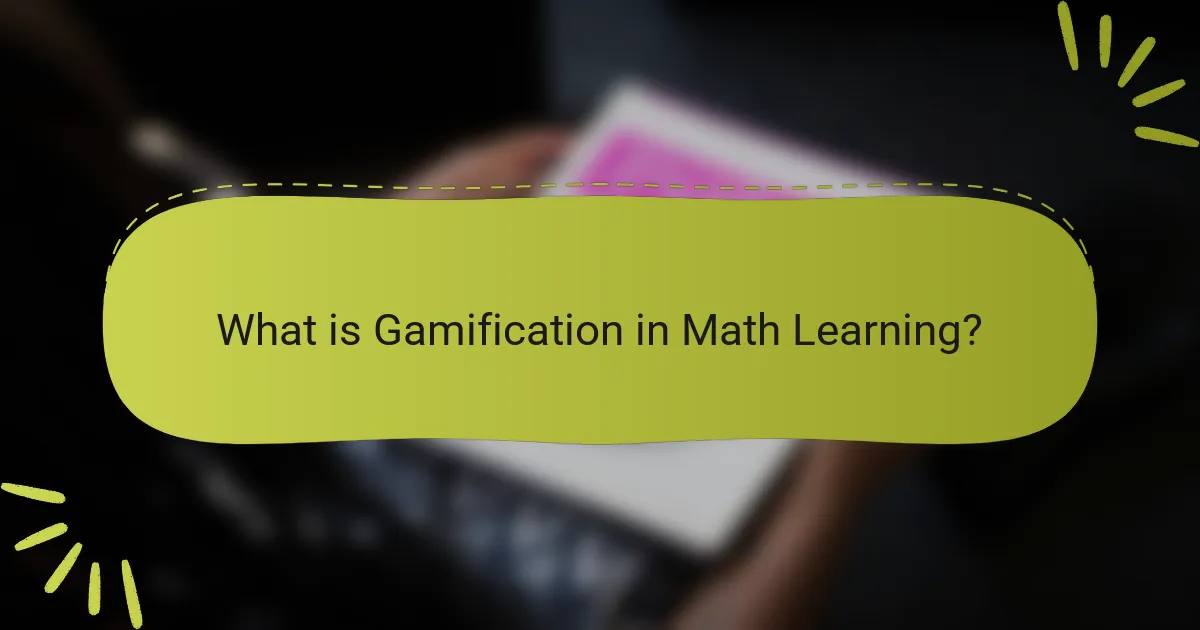
What is Gamification in Math Learning?
Gamification in math learning refers to the application of game-design elements in educational contexts to enhance student engagement. This approach incorporates features such as point scoring, leaderboards, and challenges. Gamification aims to make learning interactive and enjoyable. Research indicates that students show increased motivation and participation when game elements are integrated into lessons. For example, a study published in the “Journal of Educational Psychology” found that gamified learning environments significantly improve student performance in mathematics. By transforming traditional learning into a game-like experience, educators can foster a more effective learning atmosphere.
How does gamification enhance the learning experience in mathematics?
Gamification enhances the learning experience in mathematics by increasing student engagement and motivation. It incorporates game elements such as points, badges, and leaderboards into educational activities. This approach makes learning more interactive and enjoyable. Research shows that gamified learning can improve retention rates and understanding of mathematical concepts. A study by Hamari et al. (2016) found that gamification positively affects motivation and engagement in educational contexts. By providing immediate feedback and rewards, gamification encourages students to persist in challenging tasks. This leads to a more positive attitude towards mathematics and improved academic performance. Overall, gamification transforms traditional math learning into a dynamic and rewarding experience.
What are the core principles of gamification in educational settings?
The core principles of gamification in educational settings include motivation, engagement, and feedback. Motivation is enhanced through rewards and recognition, encouraging learners to pursue goals. Engagement is fostered by interactive content and challenges that stimulate interest. Feedback is provided in real-time, allowing students to understand their progress and areas for improvement. Additionally, clear objectives guide learners through tasks, creating a structured learning environment. Social interaction is encouraged, promoting collaboration and competition among peers. These principles are supported by research indicating that gamified learning can increase student retention and performance. For instance, a study by Hamari et al. (2014) found that gamification positively impacts user engagement in educational contexts.
How do game mechanics apply to math learning?
Game mechanics enhance math learning by promoting engagement and motivation. They incorporate elements like points, levels, and rewards. These mechanics create a competitive environment that encourages students to practice more. Research shows that gamification increases retention rates and improves problem-solving skills. For example, a study by Hamari et al. (2016) found that game elements significantly enhance learning outcomes. Game mechanics also provide immediate feedback, allowing students to learn from mistakes quickly. This approach fosters a growth mindset, essential for mastering math concepts. Overall, game mechanics make math learning more interactive and enjoyable.
What are the key features of gamification in math learning?
Key features of gamification in math learning include engagement, motivation, immediate feedback, and progress tracking. Engagement is enhanced through interactive elements like challenges and rewards. Motivation is boosted by incorporating game mechanics such as points, badges, and leaderboards. Immediate feedback allows students to understand their performance and correct mistakes in real-time. Progress tracking helps learners visualize their advancement and set goals. These features create a more dynamic learning environment, fostering a positive attitude towards math. Studies show that gamification can improve student performance and retention rates in math subjects.
How do rewards and achievements motivate students in math?
Rewards and achievements significantly motivate students in math by enhancing their engagement and self-efficacy. When students receive rewards for completing tasks, they experience a sense of accomplishment. This boosts their confidence in their math abilities. Achievements can be in the form of badges, points, or recognition. These tangible rewards create a competitive environment that encourages students to improve. Research indicates that gamification increases motivation levels in educational settings. For instance, a study by Hamari et al. (2016) found that gamified elements lead to higher student engagement and improved performance in various subjects, including math. Thus, rewards and achievements serve as effective motivators for students in math learning.
What role does competition play in gamified math education?
Competition enhances engagement and motivation in gamified math education. It encourages students to strive for improvement and mastery of mathematical concepts. Research indicates that competitive elements can lead to increased participation and effort. For example, a study by Hamari et al. (2016) found that competition in educational games significantly boosts student motivation. Additionally, competition provides immediate feedback through scores and rankings. This feedback helps students identify areas for improvement. Overall, competition in gamified math education fosters a dynamic learning environment that promotes active participation and skill development.
Why is motivation important in math learning?
Motivation is crucial in math learning because it enhances engagement and persistence. When students are motivated, they are more likely to participate actively in lessons. This active participation leads to better understanding and retention of mathematical concepts. Research indicates that motivated students show improved problem-solving skills. They are also more willing to tackle challenging problems. A study by Deci and Ryan (2000) highlights that intrinsic motivation fosters deeper learning. In contrast, lack of motivation can result in disengagement and lower academic performance. Therefore, cultivating motivation is essential for effective math education.
How does gamification influence student engagement in math?
Gamification significantly enhances student engagement in math. It incorporates game-like elements into learning, making math more interactive and enjoyable. This approach fosters a sense of competition and achievement among students. Research indicates that gamified learning can increase motivation by up to 50%. Features like rewards and progress tracking encourage students to participate actively. A study by Hamari et al. (2016) found that gamification positively influences students’ intrinsic motivation. Engaged students are more likely to persist in challenging math tasks. Overall, gamification transforms the learning experience, leading to improved engagement and academic performance in math.
What psychological factors are affected by gamification in learning?
Gamification in learning affects several psychological factors, including motivation, engagement, and achievement. Motivation is enhanced through game-like elements such as rewards and challenges. Engagement increases as learners interact with content in a dynamic way. Achievement is fostered by providing immediate feedback, which reinforces learning. Research indicates that gamification can lead to improved retention of information. A study by Hamari et al. (2014) found that gamified elements significantly boost user engagement and motivation in educational settings. These factors collectively contribute to a more effective learning experience.
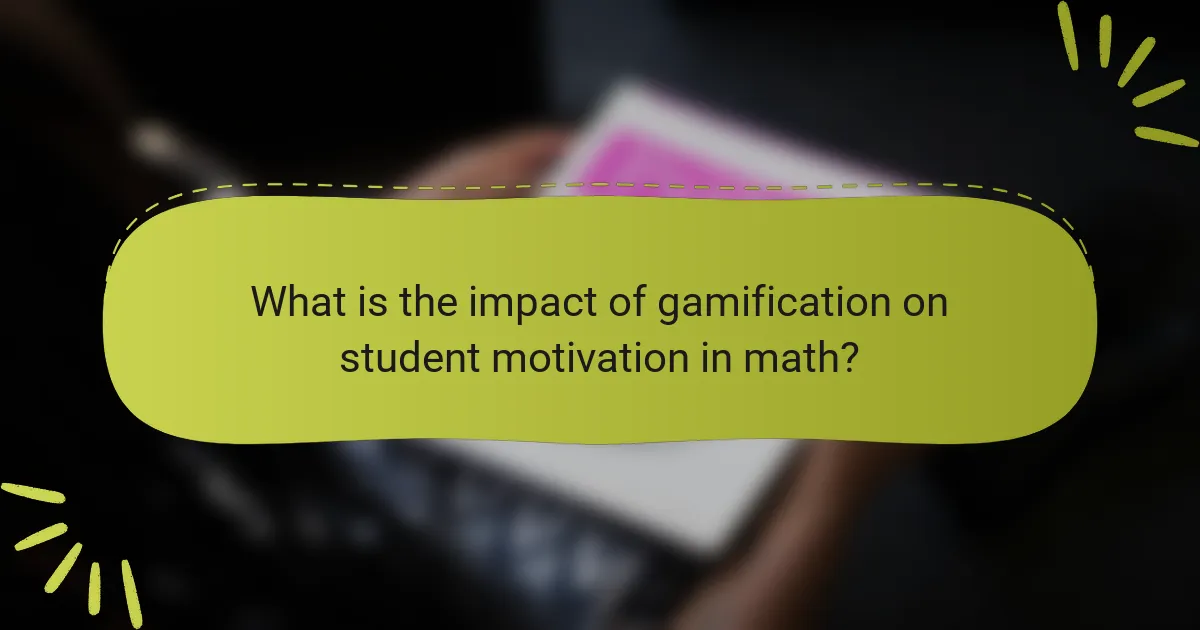
What is the impact of gamification on student motivation in math?
Gamification positively impacts student motivation in math. It engages students through game-like elements such as points, badges, and leaderboards. These elements create a sense of achievement and competition. Research shows that gamified learning environments increase student participation. A study by Hamari et al. (2014) found that gamification significantly boosts intrinsic motivation. Students are more likely to persist in challenging tasks when they feel rewarded. Additionally, gamification fosters collaboration among peers, enhancing social interaction. Overall, gamification transforms traditional math learning into an engaging experience.
How does gamification change students’ attitudes towards math?
Gamification positively changes students’ attitudes towards math by increasing engagement and motivation. Incorporating game elements into math learning makes the subject more enjoyable. Students often experience reduced anxiety when faced with math challenges in a game format. This approach encourages a growth mindset, as students learn to view mistakes as opportunities for learning. Research shows that gamification can lead to higher achievement levels in math. For instance, a study by Hamari et al. (2016) found that gamified learning environments significantly improved student motivation and performance. By transforming math into an interactive experience, gamification fosters a more positive perception of the subject among students.
What evidence supports the effectiveness of gamification in improving motivation?
Gamification effectively improves motivation in educational settings. Research shows that gamified environments increase student engagement and persistence. A study by Hamari, Koivisto, and Sarsa (2014) found that gamification positively influences user motivation. Their analysis revealed that elements like points, badges, and leaderboards enhance motivation levels. Additionally, a meta-analysis by Landers and Landers (2014) indicated that gamification leads to higher performance and satisfaction. These findings demonstrate the significant impact of gamification on motivation in learning contexts.
How do different gamification strategies impact various student demographics?
Different gamification strategies impact various student demographics by enhancing engagement and motivation levels. For example, younger students often respond positively to game-like elements such as rewards and competition. These strategies can increase participation and enjoyment in learning activities. In contrast, older students may prefer collaborative challenges that emphasize teamwork and problem-solving. Research shows that tailored gamification approaches can significantly improve learning outcomes across diverse age groups. A study by Hamari et al. (2016) indicates that gamification enhances intrinsic motivation, leading to better academic performance. Thus, applying specific gamification strategies based on demographic characteristics can yield more effective educational experiences.
What challenges might arise when implementing gamification in math education?
Challenges that may arise when implementing gamification in math education include lack of engagement, resource limitations, and varying student abilities. Some students may not respond positively to game mechanics. This can hinder motivation and participation. Resource limitations may affect the availability of technology and training for educators. Additionally, diverse student abilities can create disparities in learning experiences. Teachers may struggle to balance game elements with curriculum requirements. Furthermore, assessment of learning outcomes can be complicated by gamified approaches. Research indicates that effective gamification requires careful design to align with educational goals.
How can educators effectively address these challenges?
Educators can effectively address challenges in gamification by integrating engaging game elements into math curricula. They should utilize interactive tools that promote active participation. Incorporating rewards and recognition can enhance student motivation. Providing clear instructions and objectives helps students understand the goals. Regular feedback is crucial for tracking progress and adjusting strategies. Collaboration among students through team-based activities fosters a supportive learning environment. Research shows that gamification can improve learning outcomes, as demonstrated by a study published in the “Journal of Educational Psychology” by Hamari, Koivisto, and Sarsa. This study found increased engagement and performance in students exposed to gamified learning experiences.
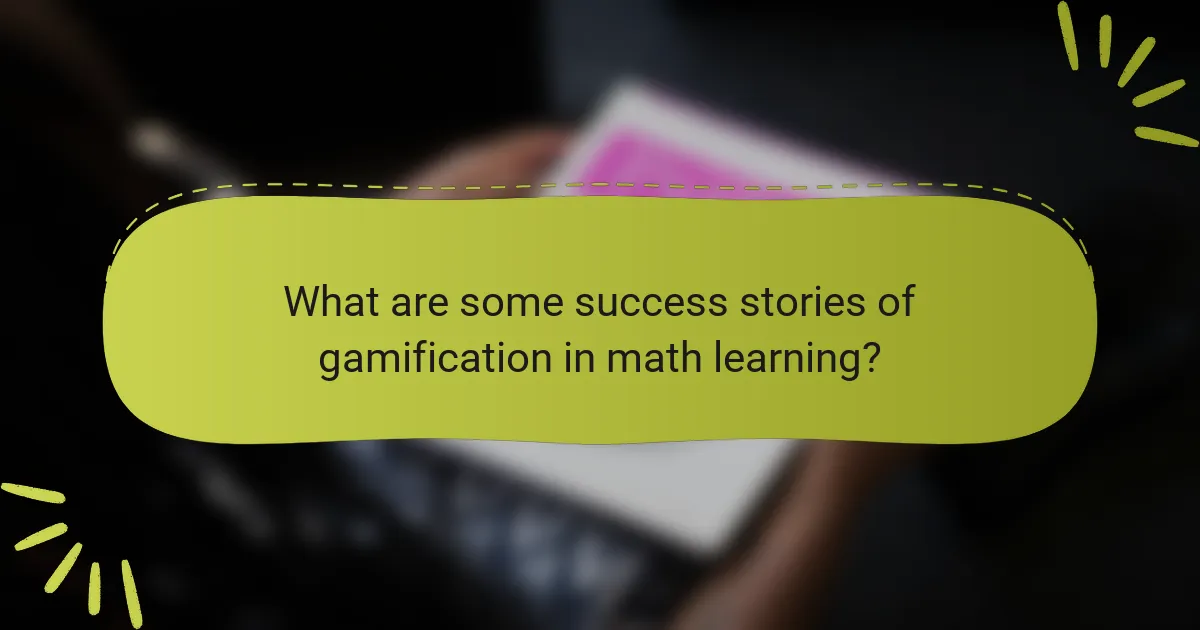
What are some success stories of gamification in math learning?
One notable success story of gamification in math learning is the use of the program “Kahoot!” in classrooms. Kahoot! engages students through interactive quizzes and games. Teachers report increased student participation and enthusiasm for math. Research indicates that 70% of students feel more motivated when learning through gamified platforms.
Another example is “Prodigy Math,” which incorporates role-playing elements into math practice. Prodigy Math adapts to individual learning levels, making it effective for diverse learners. A study revealed that students using Prodigy improved their math scores by an average of 30%.
Finally, “Mathletics” has also shown success in gamifying math education. This platform offers rewards and challenges that encourage students to practice regularly. Schools using Mathletics have observed a 20% increase in student engagement and proficiency in math skills.
What case studies highlight the effectiveness of gamification in math?
Case studies highlighting the effectiveness of gamification in math include the “Math Blaster” program and the “Kahoot!” platform. The “Math Blaster” program increased student engagement and improved math scores by incorporating game-like elements. Research by the University of Colorado found that students using “Math Blaster” scored 20% higher on math assessments compared to traditional methods.
The “Kahoot!” platform also demonstrated success in gamified learning. A study published in the Journal of Educational Technology found that students who participated in “Kahoot!” quizzes showed a 30% increase in motivation and retention of math concepts. These case studies provide concrete evidence of gamification’s positive impact on math learning outcomes.
What specific outcomes were achieved in these success stories?
Specific outcomes achieved in these success stories include improved student engagement and higher retention rates in math concepts. Many students reported increased motivation to participate in math activities. Test scores showed significant improvements after implementing gamified learning strategies. Teachers noted enhanced collaboration among students during group tasks. Additionally, students developed better problem-solving skills through interactive challenges. Overall, these outcomes indicate a positive impact of gamification on math learning experiences.
How can educators apply gamification techniques effectively in their math classrooms?
Educators can apply gamification techniques effectively in their math classrooms by incorporating game elements into lessons. These elements include points, badges, and leaderboards. Points can be awarded for completing assignments or participating in class. Badges can signify achievements or mastery of specific skills. Leaderboards can foster a sense of competition and motivation among students.
Additionally, educators can design math challenges that resemble games. These challenges can involve problem-solving tasks that students complete in teams. Collaborative gameplay can enhance engagement and promote teamwork.
Research shows that gamification can increase student motivation and improve learning outcomes. A study by Hamari et al. (2014) found that gamification positively influences engagement and performance. By integrating these techniques, educators can create a more dynamic and interactive learning environment.
What best practices should teachers follow when incorporating gamification?
Teachers should follow best practices such as setting clear objectives when incorporating gamification. Clear objectives help students understand learning goals. They should also provide meaningful rewards that align with educational outcomes. Rewards can enhance motivation and engagement. Additionally, teachers should encourage collaboration among students. Collaborative activities foster teamwork and communication skills. Regular feedback is essential to guide student progress. Feedback helps students recognize areas for improvement. Finally, integrating diverse game elements keeps the experience engaging. A variety of elements caters to different learning styles and preferences. Implementing these practices can lead to improved student motivation and learning outcomes.
What tools and resources are available for gamifying math education?
Tools and resources for gamifying math education include online platforms, mobile applications, and physical games. Online platforms like Kahoot! and Quizizz allow teachers to create interactive quizzes. These platforms engage students through competition and immediate feedback. Mobile applications such as Prodigy Math and Mathletics offer adaptive learning experiences. They provide personalized math challenges that adapt to student skill levels. Physical games include board games like “Sum Swamp” and card games like “Math Dice.” These games make learning math concepts fun and interactive. Research indicates that gamification can improve student engagement and motivation in math learning.
What are the future trends in gamification for math learning?
Future trends in gamification for math learning include increased use of adaptive learning technologies. These technologies personalize the learning experience based on individual student performance. Gamification will also leverage augmented reality (AR) and virtual reality (VR) to create immersive learning environments. Research indicates that AR can enhance engagement and understanding in complex mathematical concepts.
Additionally, the integration of artificial intelligence (AI) will provide real-time feedback and tailored challenges. AI can analyze student data to adjust difficulty levels and suggest resources. Collaborative gamified platforms will promote peer-to-peer learning and competition, fostering a community around math skills.
Moreover, there will be a rise in mobile-based gamification, allowing students to learn anytime and anywhere. Statistics show that mobile learning increases accessibility and engagement among students. Finally, educators will emphasize the importance of soft skills through gamified experiences, preparing students for real-world applications of math.
How might technology further enhance gamified learning experiences?
Technology can enhance gamified learning experiences by integrating adaptive learning algorithms. These algorithms personalize content based on individual learner progress and preferences. For instance, platforms like DreamBox Learning utilize real-time data to adjust math challenges. This ensures that students are always engaged at an appropriate difficulty level. Additionally, virtual and augmented reality can create immersive environments for learning. Research shows that immersive experiences can improve retention rates by up to 70%. Furthermore, data analytics can track student performance, allowing educators to make informed decisions. This targeted approach can lead to improved outcomes in math learning.
Gamification in math learning refers to the integration of game-design elements in educational settings to enhance student engagement and motivation. This article explores the key features of gamification, including immediate feedback, progress tracking, and competition, and examines its impact on student motivation and attitudes towards math. It highlights research findings that demonstrate improved retention rates and academic performance in gamified environments. Additionally, the article presents success stories and case studies that illustrate the effectiveness of gamification in transforming traditional math education into an interactive and rewarding experience.
